The hibiscus plant is a flowering plant with hundreds of species that are native to locations all over the world. Leaving it at that would be selling the humble hibiscus short, however.
For thousands of years, hibiscus has been popular with people all over the world for several reasons. Some like its ornamental uses in the garden, others have found medicinal properties while others still have used it for slightly more arcane purposes.
Even today, hibiscus tea is very popular all around the world. And despite its popularity, there are some people who should take care in consuming it.
They’re perennials, meaning that they last for several years. They’re also quite hardy plants, so they can survive with minimal maintenance, which is one reason why they’re so popular with gardeners the world over.
Whether you want to learn how to grow hibiscus yourself or want to use it to power up your magic spells (yes, really), this article is for you. Its aim is to teach you everything you could possibly want to know about the hibiscus plant and a few things that you need to know.
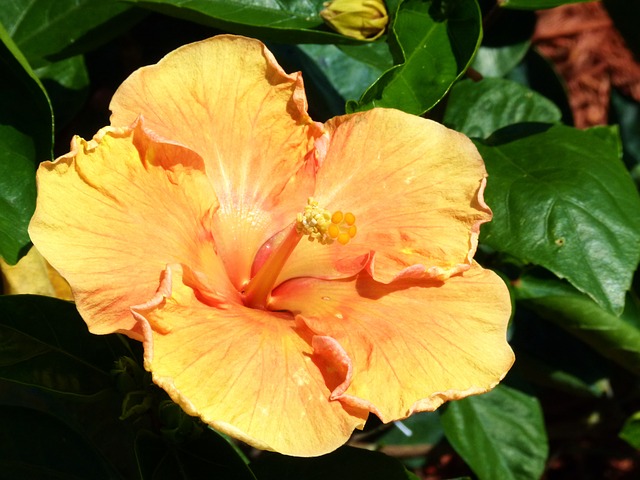
Varieties & Types of Hibiscus
Hibiscus is a genus that belongs to the family Malvaceae with several hundred different species recorded. If you’d like to see a large list of these species, Wikipedia is the place for you.
If you’re like most people though, you probably just care about the main few types of hibiscus. Below we’ve listed out a few of the more popular and common types.

The most common type, and the one that you probably picture when you think about hibiscus, is hibiscus syriacus. This is a plant that is native to China, but was given its name because it was later cultivated in Syria.
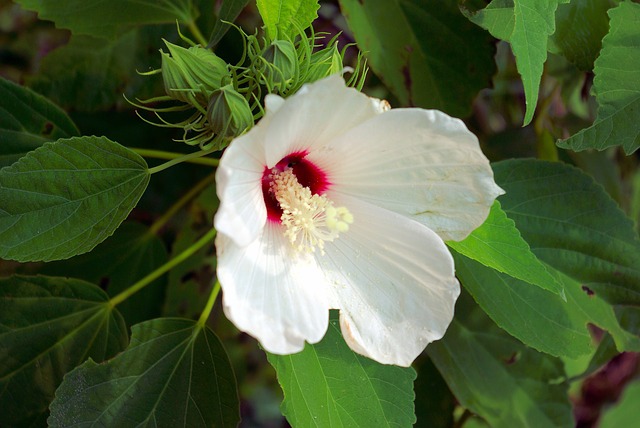
The hibiscus moscheutos is another popular hibiscus from North America and is commonly found around wetlands. It’s also known as the swamp rose-mellow. In addition to being popular features in gardens, they’re also popular with bees who use them for nectar.
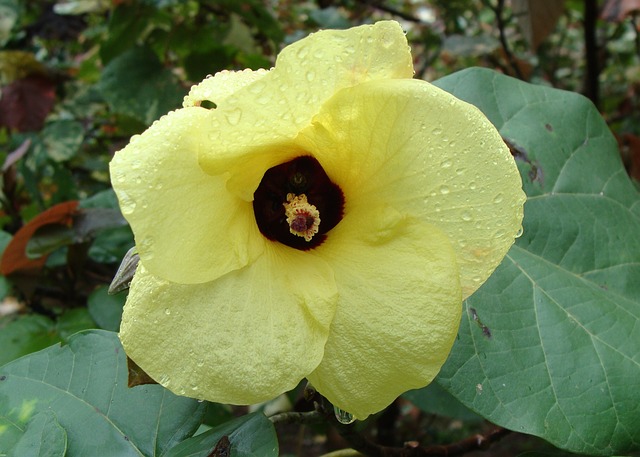
Hibiscus tiliaceus, or the beach hibiscus is another popular variety. It is found natively in Australia and other parts of tropical Asia.
This tends to be larger than some of the other varieties we’ve mentioned above, with sizes ranging from 4-10 metres in height.
While the flowers are often yellow upon opening (see the above picture), the flowers change colour to orange and red before finally falling to the ground.
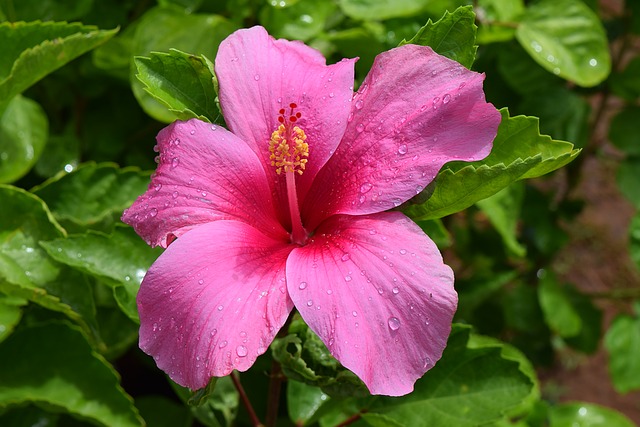
Hibiscus rosa-sinensis, also known as the Chinese hibiscus, is a tropical hibiscus native to East Asia. It’s a bushy shrub growing in size from around three to five metres.
As with other tropical hibiscus, it is also popular amongst birds that feed on nectar, but surprisingly hummingbirds do not seek it out in South America; only in the old world tropics.
How to Grow Hibiscus Successfully
Hibiscus plants tend to have large, bright, flowers so it’s not a surprise that they’re popular in gardens all over the world.
They also have the added benefit of attracting birds and bees, so there are plenty of reasons to add them to your garden.
While there are hundreds of species of hibiscus, they tend to fall into three main categories:
- Tropical hibiscus
- Hardy Perennial hibiscus
- Hardy Shrub hibiscus
How to Grow Tropical Hibiscus
Here are some tips on growing tropical hibiscus plants. An example of a tropical hibiscus is the Chinese hibiscus featured above.
As the name suggests, tropical hibiscus grow best in warmer climates.
If you’re living in a colder part of Australia, you might need to bring them indoors during the colder months, but most people in Australia will be fine growing them.
They typically grow best in zones 9-10, and if you’re not aware of what cold hardiness zone you live in, then you can check here:
https://www.anbg.gov.au/gardens/research/hort.research/zones.html
When it comes to light, tropical hibiscus love lots of it. Place them somewhere in your garden where they’ll get as much as possible.
These hibiscus also thrive on regular fertilisation, so if you’re going to grow tropicals in your garden, use a balanced NPK fertiliser.
How to Grow Hardy Perennial Hibiscus
Here are some useful tips on growing hardy perennial hibiscus, an example of which is the hibiscus moscheutos, as featured above.
These hibiscus, as their name (again) suggests, can be grown just about anywhere outside the arctic regions. Unless you’re planning an expedition to the South Pole, you should be right growing these regardless of where you live in Australia.
They love plenty of sun, so make sure you plant them somewhere that gets plenty of light.
Since these are often known as wetland plants, it won’t come as a surprise to learn that these plants love lots of water. Even in summer do what you can to keep their soil moist.
Using fertiliser is also a good idea when trying to grow hardy perennial hibiscus.
How to Grow Hardy Shrub Hibiscus
Finally we take a look at some tips on how to grow hardy shrub hibiscus; an example of which is the hibiscus syriacus, as featured above.
These hibiscus are a little fussier as to where they’ll grow; they prefer more temperate climates to the tropics.
If you’re in one of Australia’s main cities then you shouldn’t have any problems growing shrub hibiscus, but if you’re up north then you might want to try growing something else.
That said, they are hardy plants, so if you are able to grow them, they’re usually pretty hard to kill.
They like lots of sun and when it comes to soil and fertiliser requirements, you can get away with a lot, so don’t stress too much.
Dealing with Pests
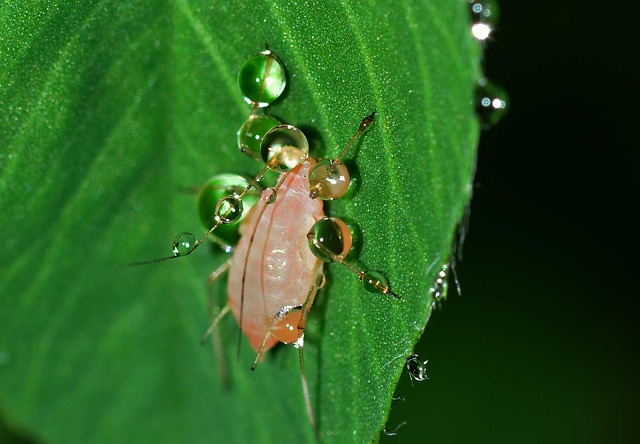
As with many other types of plants such as orchids, humans aren’t the only creatures on planet Earth that enjoy hibiscus.
If you plan on growing hibiscus then you’ll need to learn the signs of pest infestation as well as how to rid your plants of them if they do appear. You can also use certain plants to attract and deal with pests.
The three most common pests for hibiscus plants are aphids, thrips and mealybugs.
Aphids: These are tiny little pests that appear in clusters and suck the juice from the foliage. You can get rid of aphids on your hibiscus with horticultural oil or insecticidal soap.
Mealybugs: These pests also suck the juice from your plants, leaving them worse for wear. You can get rid of them with horticultural oil or insecticidal soap as mentioned above.
Thrips: These tiny pests lay eggs inside hibiscus buds and can cause the buds to drop off completely. Because the infestation happens inside, the best method for ridding your hibiscus of thrips is to use horticultural oil.
Other uses for Hibiscus
So far we’ve had a good look at how to grow hibiscus, but did you know there are lots of other ways to use hibiscus?
How to Make Hibiscus Tea
To start with you’ll need to get your hands on some fresh hibiscus flowers. About two cups worth will do the job. Add to two litres of water and bring to a boil. Once the mix begins to boil, remove it from the heat and cover it.
Let the tea set for 15-20 minutes and then either serve it hot or add some ice cubes and serve it cool. As well as tasting pretty good it has a brilliant red tint to it.
Things to be Aware of:
Hibiscus tea and pregnancy: As delicious as hibiscus tea may be, there are a couple of considerations. Because it can affect estrogen levels, it should be avoided if you are pregnant or trying to get pregnant.
Hibiscus tea and blood pressure: There’s also some evidence to suggest that consuming hibiscus tea regularly for several weeks can lower blood pressure.
Hibiscus tea and drug interactions: There are also some possible drug interactions for hibiscus tea, so if you are currently on any medications, check this link to make sure you’re not in danger.
Using Hibiscus Plants to Make Rope
Hibiscus isn’t just for those who like gardening or drinking herbal tea; there are also some practical benefits. Some people have been known to use the hibiscus plant to make rope and in the following video you’ll see just how to do that:
Using Hibiscus in Magic & Witchcraft
Are you unlucky in love? Is Tinder not really your thing? If so, perhaps witchcraft is for you.
In the world of witchcraft, hibiscus is a popular flower for use in spells. Many witchcraft practitioners (“witch” is no longer considered politically correct) believe that hibiscus incites passion, so they tend to use it in spells for attracting love and lust.
It is also believed to help with clairvoyance. Placing hibiscus leaves in a wooden bowl of water is said to increase your powers.
After doing some digging around the internet, we’ve managed to get our hands on one hibiscus spell that you can use to make someone fall in love with you. Use responsibly!
Step 1: Get your hands on a perfect specimen of a hibiscus flower
Step 2: Wear the flower in your hair for several hours
Step 3: Offer the hibiscus flower to the person whose heart you want to win
If they accept your flower without question then they’re all yours!
Hibiscus FAQ
Q: Why are hibiscus leaves turning yellow?
A:There are two main reasons your hibiscus leaves will turn yellow; light and water. If your hibiscus is getting either too much or too little of either water or light, chances are the leaves will turn yellow.
Q: Does hibiscus tea contain caffeine?
A: No, hibiscus tea does not contain any caffeine.
Q: Are hibiscus flowers poisonous to dogs?
A: It depends on the type of hibiscus. The hibiscus syriacus is toxic to dogs if ingested, although they are safe for human consumption. The toxin that harms dogs has yet to be identified.
Q: Are hibiscus flowers poisonous to cats?
A: No, all species that we know of are not toxic to cats whether ingested or otherwise.
Q: Will hibiscus grow inside?
A: Many of the hibiscus varieties are called hardy for a reason, so they will grow inside if they’re cared for correctly. One difference between outdoor grown hibiscus and indoor hibiscus is the flower size; the ones grown indoors will have smaller flowers. If you live in a cold climate you might even need to grow your hibiscus indoors during Winter.
Q: Will hibiscus cure dandruff?
A: Some people believe that hibiscus leaves can help deal with dandruff. It’s thought that the oil contained in the leaves has beneficial properties. To use hibiscus leaves for your dandruff, grind up some leaves until they make a paste and then apply the paste to your scalp. Leave it in there for some time and repeat as necessary until your dandruff subsides.
Q: Will hibiscus survive frost?
A: It depends on the type of hibiscus. Hardy hibiscus, as the name suggests, can survive most conditions. Tropical hibiscus on the other hand is native to tropical areas (surprise, surprise) so they won’t tolerate frost at all. One hard freeze could very well kill the plant, so if you have tropical hibiscus and you live in an area that has frost, then you’ll need to bring the plant indoors if you want it to survive.
Q: Will hibiscus root in water?
A: Yes, you can grow hibiscus cuttings in water. They typically do better in regular soil but they can easily be started in water.
Q: Where can hibiscus be found?
A: Hibiscus can be found just about everywhere. While tropical species of hibiscus are found mostly in the tropics, hardy hibiscus are found almost everywhere outside of the North and South poles.
Q: How does hibiscus lower blood pressure?
A: While some studies have suggested that drinking three cups of hibiscus tea each day for several weeks can have a positive effect on your blood pressure, scientists are yet to discover the mechanism by which hibiscus tea works on your blood pressure.
Q: Hibiscus is the national flower of which country?
A: Hibiscus flowers are the national flowers of several countries. Hibiscus syriacus is the national flower of South Korea, while its cousin the Hibiscus rosa-sinensis is the national flower of South Korea.
Q: Does hibiscus like coffee grounds?
A: It does appear that hibiscus plants like coffee grounds; this seems to be because hibiscus is an acid loving plant and coffee grounds contain lots of chemicals that help it grow strong.
That’s all folks!
Well, that’s all we have for you on the hibiscus plant. If there’s something you think we left out, or if there’s something you’d like us to add to the guide, please leave us a comment below and we’ll see what we can do.

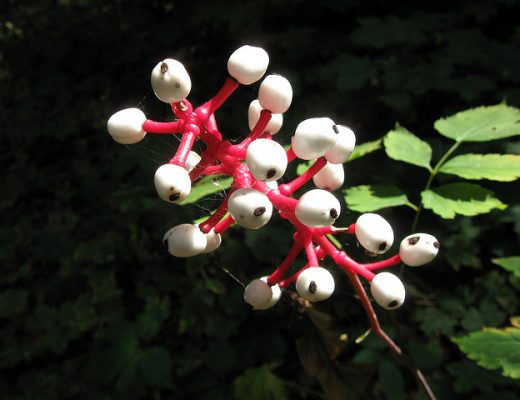
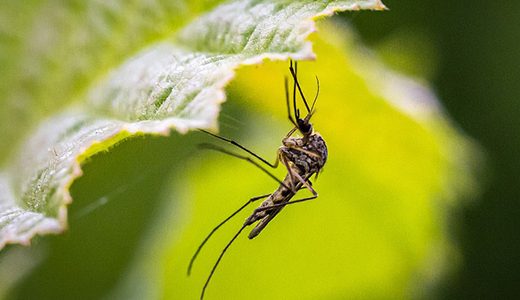

Larry Bruner
February 22, 2019 at 1:05 pmVery good Sean.
clarrie
March 15, 2019 at 6:51 pmyou did not say any thing about using them as cut flowers and how to make them last
Ros
December 2, 2019 at 8:50 amWhile commenting on which countries that have Hibiscus as the national flower, both H. Syriacus and H. Rosa-sinensis are listed as the national flower of South Korea, but your commentary would imply otherwise.
I think that you have made a mistake; should one of these countries be North Korea?
Vivienne Caroll
March 21, 2020 at 6:34 pmCan I float cut hibiscus flowers on a fishpond without making the water toxic to fish?
Also how to kill off the hibiscus flower beetle that is ruining my beautiful hibiscus blooms.
Vivienne
Sean
March 24, 2020 at 3:59 pmHi Vivienne,
The ASPCA tells me that hibiscus is non-toxic to animals.
The best way to control hibiscus flower beetles is probably with an insecticide such as Imidacloprid.
Hope that helps!
Sean